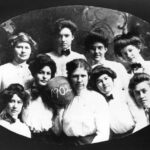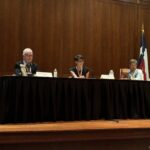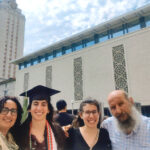Letters to Texas
The life and times of celebrated author Shelby Hearon.

You can practically smell the kolaches in Shelby Hearon’s 1991 book Hug Dancing, when her heroine visits a fictionalized version of the iconic Westfest in Czech-checkered West, Texas. Every detail is simple and perfect, every apricot-jam-filled breeze in the humid air is welcome and relieving. You can almost hear the polkas and taste the garlicky sausage. That’s how skillfully she could weave in the quotidian details of life into her works.
Hearon, BA ’53, Distinguished Alumna, died at home in Burlington, Vermont on Dec. 10, 2016. The novelist and short story writer was born in Kentucky in 1931, moved to Texas in 1947, and stayed until 1981, raising her children, Anne and Reed. Throughout her 40-year career, she penned more than 15 books, 10 of which are set in Texas. Her characters tangled with the small foibles of life after “I do,” life with burdens and hopes and small, emotional complications. Her writing is intimate, intense, and meticulously crafted—she was known to thoroughly mark up and revise manuscripts before submission. She spent a lot of time perfecting her craft, starting at a young age. Her composition teacher at Austin High School once held her after class, waved her essay underneath Hearon’s nose, and asked: “Who wrote this for you?” Her senior year, she won the UIL ready-writing contest.
“You need to write alone until you find your own style, your own voice, and sharpen what makes you different from other writers,” she once said in an interview with the Borzoi Reader. What made Hearon different, according to those who knew her, was her wit, energy, and ever-churning sense of caring and purpose. Joan R. Baskin, BA ’52, Life Member, her 1951-52 roommate at the Pi Phi house, says she had “that rare and enviable trait of truly caring about her friends … whether they live in California, New Jersey, or West Texas.”
Hearon was outgoing, a leader involved in numerous civic and UT entities as both a student and a graduate, including the LBJ School and the Plan II program, from which she graduated in 1953. She served on the program’s advisory committee during its 50th anniversary, and in 1987 told the Alcalde: “Plan II taught me to study, to approach a problem by moving from the theoretical to the particular—and I still write and think that way.” In a 2001 interview, she told the Austin Chronicle the two things she missed most about Austin after moving away: Barton Springs and the university, which she said felt the same even after Austin’s continuing growth.
She gave talks and taught across Texas and the nation. She served on the state arts councils of Texas and New York. Over the course of her career, she earned the NEA/PEN Syndication short story prize five times, the Texas Institute of Letters fiction prize twice, a Guggenheim Fellowship, and an American Academy of Arts and Letters fiction award. Her papers are collected at the Harry Ransom Center.
Loss, and how we tangle with it, is a common theme in her writing. In her first novel, Armadillo in the Grass, her protagonist struggles to create something that will outlive her. Reflecting on the book, she wrote: “I was dealing with the invisibility of women. Can they leave something behind besides children? It is this that drives my woman to become an artist, to leave something tangible behind.”
Photo by Phyllis Frede, courtesy of Anne Hearon Rambo














1 Comment